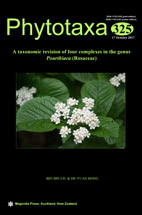Abstract
The taxonomy of four species complexes of Pourthiaea (i.e., P. arguta, P. pilosicalyx, P. salicifolia, and P. sorbifolia), distributed in E, S, and SE Asia, is extremely controversial among authors. This situation may have been caused by the lack of proper analysis and evaluation of the characters at the population level used previously. The present study is the first comprehensive taxonomic revision of these four complexes. We conducted extensive field observations, population sampling, examination of a large number of specimens, and did subsequent statistical analysis of the characters. All the morphological characters used in previous taxonomic treatments were evaluated one by one at the population level. They are length, width, margin, number of lateral veins, type of base, type of apex, and shape of leaf blade, length of petioles, type of inflorescences, length of pedicels, and density of indumentum on leaf blade and inflorescences. All these characters were found to be extremely variable within population and continuously varied between populations, and thus they are of little value for delimiting species. However, seven characters, i.e., width of leaf blade, lateral veins of leaf blade parallel or not, lower surface of leaf blade glabrescent or not, type of fruit, sepals caducous or not, number of carpels, and ratio of number of fertile seeds to that of total seeds, were found distinctly different (for qualitative characters) or statistically discontinuous (for quantitative characters), and thus they are valuable for species delimitation in these four complexes. As a result, we recognize four species and two subspecies, P. pilosicalyx, P. salicifolia, P. sorbifolia, and P. arguta which consists of two subspecies: subsp. arguta and subsp. pustulata. Two new combinations, P. sorbifolia (W. B. Liao & W. Guo) B. B. Liu & D. Y. Hong and P. arguta subsp. pustulata (Lindl.) B. B. Liu & D. Y. Hong, are proposed herein. Forty-one taxa are reduced as new synonyms, and 20 lectotypes are designated here.

